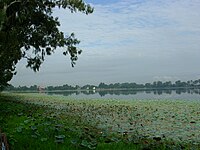MajuliMajuli is the world’s biggest riverine island and a principal place of pilgrimage for the Vaishnavites of Assam since the Ahom days. There are several Satras of Vaishnava religious creed. Of these holy seats, Auniati, Daksinpath, Garamur and Kamlabari are the four most prominent. What is of special importance is its satra establishment, consisting of separate structures, built for different purposes.
Kaziranga National Park
Kaziranga National Park, the oldest in Assam lies partly in Golaghat District and partly in Nagaon District of Assam. It covers an area of 430 Sq. Km. IT is the best home of the Great Indian one horned rhinoceros. The landscape of Kaziranga is of sheer forest, tall elephant grass, rugged reeds, marshes & shallow pools. Kaziranga has been declared as National Park in 1974.
DHEKIAKHOWA BARNAMGHAR : Established during 1497-1539 by saint-reformer Madhavdeb
LACHIT BORPHUKAN'S MAIDAM : Greatest ever Ahom General who defeated the mighty Mughals at Saraighat in 1672.
JORHAT GYMKHANA CLUB : Built in 1876 by D. Slimmon, the then Secretary of the club.
Bangalpukhari
On the southern side of Jorhat, near Na-ali, there is a tank popularly known as Bangalpukhari. In the month of Sravana of Saka 1739, Badan Barphukan was murdered by Rupsinghh Bangal when he was going to take bath. For this act , he was rewarded with some money which he spent in excavating this tank. The people do not use the water of this tank as it was excavated with the money received for killing a man.
THENGAL BHAWAN : Build in 1880 by Raibahadur Shiva Prasad Barooah, the first Assamese Daily Dainik Batari was started from this complex. build.jpg (45438 bytes)
Burigosain devalay: The Burigosain and the priest were brought from Jayantiya after defeating that king and were established first at Rangpur. When the capital was shifted to Jorhat, the image of Burigosain was also shifted and placed in a temple which lies in the middle of the town. It is a sakta Shrine.
Purnananda Buragohain Maidam: There is a maidam on he bank of Toklai near Macharhat which is of Purnanand Buragohain. It was constructed by his son.
college.jpg (49110 bytes) EASTERN THEOLOGICAL COLLEGE : Established in 1856 as Jorjat Christian School, subsequently named Theological College.
Kunwori pukhari: About two Miles east of Jorhat town near the Trunk road there is a big tank which is known as Kunwori pukhari. The grand daughter of Sataialia Dilabandha Borgohain was made the Parbatia Kunwari by king Gaurinath Sinha. The Parbatia Kunwori constructed the tank.
Garh Ali: A big embarkment was constructed to protect the Ahom kingdom from the Moamarias and it extended from Seoni Ali to Naga hills. Having seen this, The Moamarias got bewildered and hence this came to be known as Bibuddhi Ghar.
Bilvesvar Siva Temple: About 35 Km. North of Jorhat town by the side of South Trunk Road there lie ruins of an old and small temple, along with a tank built by Rucinath Burgohain.
Gazpur: At a little distance towards north of Bilveswara temple the remains of Hathigarh can be seen. The Garh was erected to capture elephants. The king decided to make a town by collecting one thousand elephants. But it was difficult to collect so many elephants. Therefore the king gave up the idea and named the place as Gazpur.
Magolu Khat: Magolu Khat is situated about four miles west of the Jorhat town. The king Rajeshwar Sinha established the Magolus or Manipuris here after marrying Kuranganayani, the princess of Manipur at Manaimaji vilage.
Ladaigarh: King Pratap Sinha constructed a garh on the north and south to protect the kingdom. One part of this garh is called Mera garh which is Majhuli. Swalat garh is on the northern side and Ladai garh on the southern side.
Raja Maidam: The existing maidam (vault)which lies on the south bank of Toklai river on the northern side of Jorhat town is of king Purandar Sinha who expired on 1st Oct 1894. The present maidam was constructed to preserve the ashes of the late king.
Baduli Pukahuri: During the reign of the king Jayadhvaj Sinha a tank was excavated by Baduli Borphukan near the Trunk Road at Teok, and it was named after Baduli Borphukan.
Borbheta: Situated 5 K.M. from Jorhat town Borbheta is known for Assam Agriculture University, District Jail, Jorhat police Reserve and the Christian Mission Hospital.
Karanga: It is a village famous for its Black smithy which caters to the demand of neighbouring tea estates and local people.
Nimati: Situated at a distnace of 17km.from Jorhat, It is an important river port of the district as well as of Upper Assam.
CINNAMORA TEA ESTATE : First tea garden of Assam established by Maniram Dewan in 1850.



































